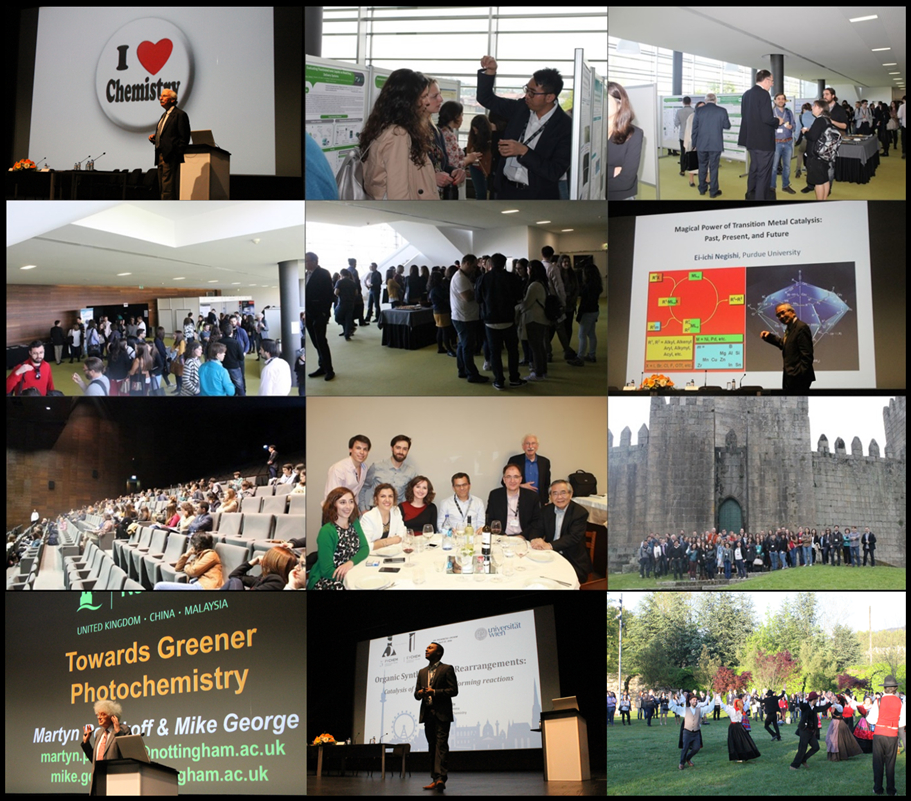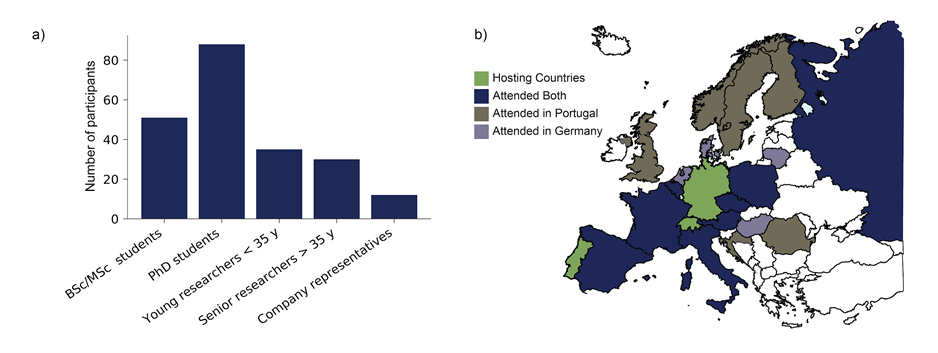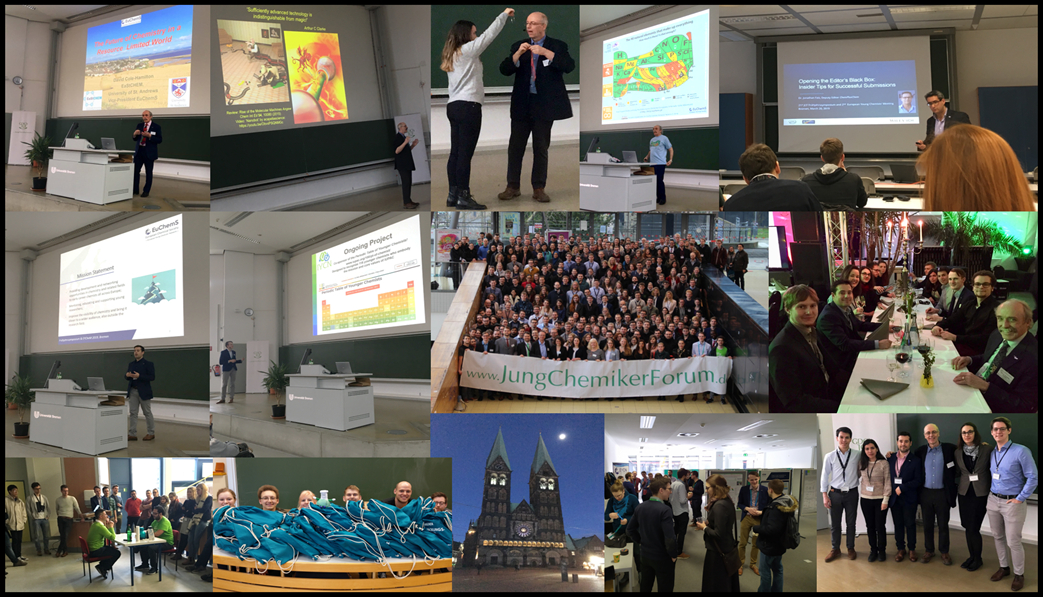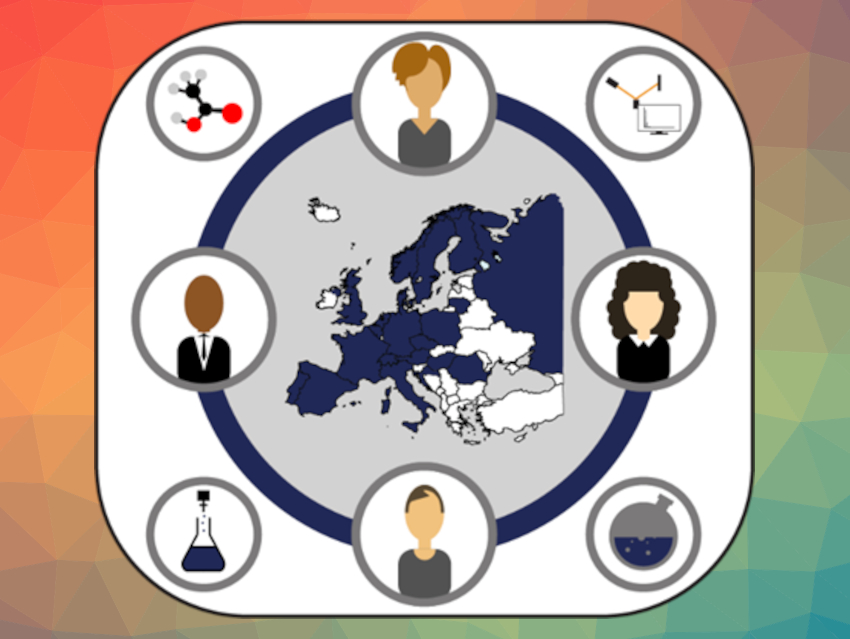Networking is known to be one of the most important pillars of professional development. With this in mind, the European Young Chemists’ Network, the young division of the European Chemical Society, has created a platform for biennial meetings of early-career chemists across Europe—the European Young Chemists’ Meeting—aiming to bring together young chemists, allow them an opportunity to present their research in front of a global audience, foster networking with peers, expand their portfolio of soft transferable skills and launch the seeds for fruitful and long-lasting collaborations.
This article provides a perspective on the relevance of this event for early-career scientists, and discusses challenges and perspectives for supporting, connecting, and empowering the next generation of chemists. Moreover, it invites more senior and established scientists to actively contribute, as mentors and role models, by advising, supporting, inspiring, and shaping the career development of young scientists.
Introduction
Supporting, connecting, and empowering young scientists through the development of their professional skills is critical to their careers and the advancement of our society [1–3]. In a study performed by the Global Young Academy, building networks and mentoring were among the most important actions needed to support young scientists [1]. Mentors could provide advice, support, and share their experience to help young scientists in decision-making, leading to better career choices and higher professional success while providing increased career opportunities [4,5]. In addition, building collaborative networks is an important factor in stimulating both personal and professional development [6–9].
For young scientists to be empowered, expand their portfolio of transferable skills, build networks, and meet prospective mentors and role models, their active participation in scientific conferences is a must. In particular, they should be provided with opportunities to attend and, very importantly, to present their work in front of a supportive global audience, engage with peers, and gain international experience [6]. In this regard, it is important to have international scientific conferences devoted to young chemists in addition to national scientific conferences, where the majority of the attendees are local. Thus, young chemists can benefit from a complete, enriching, and fulfilling personal and professional experience that an international environment entails. For this purpose, the European Young Chemists’ Network (EYCN) [10], the young division of the European Chemical Society (EuChemS) [11], has created a platform that is strongly committed to bringing together, supporting, connecting, and empowering young chemists across Europe—the European Young Chemists’ Meeting (EYCheM).
The EYCheM is a scientific conference specifically devoted to young scientists working across the chemical sciences. For many participants, this is the first international scientific conference where they have an opportunity to present their research in front of a global audience. Therefore, the EYCheM intends to provide a dynamic, inspiring, inclusive, diverse, equitable, and memorable conference experience for young scientists. During the EYCheM, the community of young chemists has a unique opportunity to present their scientific work, which is otherwise often a privilege reserved for senior researchers and professors. As a result, the EYCheM strengthens their visibility and confidence in front of an international audience, enables them to connect with peers, and benefit from multiple activities specifically tailored to their needs, such as soft skills workshops, CV clinics, and meetings with industrial practitioners.
The venue also allows early-career scientists to closely interact, network, engage and learn from each other, as well as from well-established academics and industrial representatives that could act as role models and become potential mentors in advancing their career progression. Established scientists linked to either academia or industry will also benefit from attending the EYCheM by interacting closely, engaging, and potentially recruiting young scientists to join their groups and contribute to advancing their fields of research. Moreover, the EYCheM is also organized by young scientists, who thereby have a unique opportunity to develop their leadership, communication and organizational skills, and gain international visibility in the process.
The following text provides an overview of the history of the EYCheM, discusses challenges and best practices of conferences targeted at early-career scientists, and offers a glimpse into virtual conference alternatives, providing a perspective on the EYCheM and similar conferences in the future.
The History of EYCheM
The EYCheM creation dates back to April 2016 when the 1st EYCheM was jointly organized with the 5th Portuguese Young Chemists Meeting (5th PYCheM) by the Young Chemists Group (Grupo de Químicos Jovens, GQJ) [12] of the Portuguese Chemical Society (Sociedade Portuguesa de Química, SPQ) in Guimarães, Portugal [13–16]. The PYCheM is a biennial scientific conference for the community of Portuguese young chemists taking place throughout Portugal since 2008. This scientific conference provides a stimulating environment and a unique opportunity for young scientists to present their research across the chemical sciences, as well as to network, discuss ideas, engage, and foster fruitful collaborations with peers and scientists as well as professionals in the chemistry field [15].
However, PYCheM did not attract many young chemists from outside of Portugal over the past years. In addition, other national scientific conferences targeting young scientists have been also organized in distinct European countries and faced the same challenges (see Tab. S1 in the Supplementary Information). This is undoubtedly a limitation of national scientific conferences that has inspired the joint organization of the PYCheM and EYCheM, which was officially endorsed by EuChemS.
The meeting attracted and engaged young scientists from across Europe and beyond in a high-quality scientific program and enriched scientific forum (see Fig. 1). The meeting featured keynote lectures by distinguished world-leading scientists, including Nobel Laureates, as well as oral and poster presentations by young scientists. Moreover, the participation of young chemists experiencing different backgrounds provided a unique environment for scientific and cultural exchange that enriched all attendees.
 |
|
Figure 1. Scientific talks, networking, and social events at the 5th PYCheM and 1st EYCheM held in Guimarães, Portugal, in April 2016. Image credit to the conference organizers and attendees. |
Indeed, statistics from the 1st EYCheM (see Fig. 2a) show that the largest participant groups were Ph.D. students (40 %), followed by B.Sc./M.Sc. students (23 %) and young researchers (16 %) [13–16]. Thus, the organization of EYCheM became an important event for the benefit of the community of young chemists across Europe. After a successful first edition, the organization of the EYCheM was formalized, inviting the EYCN Delegates to express their interests to organize the next edition. During the Delegate Assembly (DA) in Heraklion, Greece, in May 2017, it was decided by the Delegates that the 2nd EYCheM would take place in Bremen, Germany, in March 2019.
 |
|
Figure 2. (a) Distribution by the academic level of the attendees of the 1st EYCheM held in Guimãres, Portugal. (b) European countries that have taken part in both EYCheMs (blue), countries’ representatives that only took part in Portugal (brown), countries’ representatives that only took part in Germany (light purple), and hosting countries (green). |
The 2nd EYCheM was merged with the 21st annual German Young Chemists Meeting (“Frühjahrssymposium” or FJS) of the Young Chemists Forum (JungChemikerForum, JCF) supported by the German Chemical Society (Gesellschaft Deutscher Chemiker, GDCh) [17,18]. The 2nd EYCheM was a success, gathering and stimulating scientific and non-scientific interactions among young chemists internationally, as well as prolific discussions with world-renowned scientists and potential future mentors (see Fig. 3). The 1st and 2nd EYCheM jointly attracted young chemists from 25 different countries (see Fig. 2b), fulfilling the goal of bringing together young chemists from across Europe and beyond. As such, the EYCheM has been established in the community of young chemists as a biennial conference, taking place in different European countries.
The 3rd EYCheM was planned to take place in Fribourg, Switzerland, in January 2021, organized by the Young Swiss Chemical Society (youngSCS) and supported by the Swiss Chemical Society (SCS). However, due to the global pandemic caused by SARS-CoV-2, the 3rd EYCheM has been postponed to January 2022.
Despite the enormous global challenges that the pandemic entails, it is pivotal that the young chemists’ community remains active and engaged in contributing to promoting and advancing chemistry knowledge and scientific discoveries, while simultaneously advancing their career development. The current circumstances turn in-person conferences almost impossible to pursue for the safety and health benefit of both the attendees and the organizers. Therefore, the community has been taking advantage of digital resources and online meetings to foster scientific exchanges, advance professional development, and promote valuable social interactions in a virtual setting [19,20].
Virtual Meetings and EYCheM
In-person scientific conferences provide unique opportunities to remain up-to-date with research, expand knowledge, interact and engage closely with peers and world-distinguished scientists, grow professional networks, and establish long-lasting collaborations that drive modern science and advance career development [21]. However, with the pandemic, in-person gatherings had to be postponed or even canceled, and several scientific conferences and meetings were moved into virtual venues which have proved to be increasingly popular within the scientific community [19].
Online conferences promptly took the spotlight, revealing advantages as compared to physical conferences. For instance, the amount of time and resources that have to be invested by both the organizers and attendees represent critical limiting factors of in-person conferences, especially for international participants [22,23]. In addition, family commitments, health issues, or financial constraints can make virtual meetings and conferences more attractive owing to their increased flexibility, enabling the attendance of a global audience from their home locations [24,25].
However, despite these advantages and the sustainability of virtual conferences due to the reduction of the carbon footprint, they cannot replace the spirit and experience of in-person meetings that enable scientists to more effectively communicate and socialize, network, and discuss topics in a much more intimate setting [19]. In this regard, regular coffee breaks, lunches, dinners, and social events during in-person scientific conferences provide informal occasions where new and innovative ideas and projects can be discussed, nurtured, and developed, enabling long-lasting collaborations to flourish. This combination of research exchange, networking, and social interactions creates memorable experiences and personal and professional connections, but also new ideas and fruitful collaborations, which are essential and cannot be easily achieved by virtual gatherings.
It is, thus, worth considering a compromise that provides both an in-person and a virtual platform to interact, such as in a hybrid format. This may become more prevalent in the future, particularly with the development of new and innovative technologies that would enable more interactive experiences online. A hybrid setting entails higher flexibility and is much more inclusive and accessible. A broader audience can participate no matter where they are located. In addition, in-person conferences are limited to a certain number of attendees depending on the venue, whereas a hybrid event entails a much higher reach and attendance.
However, it is important to ensure that both audiences have a comparable conference experience with equal opportunities. For that purpose, advancements in technologies and their innovative use should enable access to the same program content and equal engagement of the remote attendees with the presenters and other attendees similar to what on-site attendees experience. This should include the possibility for the virtual attendees to engage and pose questions to the panelists and participate in video calls, coffee breaks, and science cafés or quizzes to foster connection and socialization, encourage and enable networking opportunities, and trigger new collaborations.
Besides the attendees, the sponsors would also benefit from a hybrid scenario. They could have their own booth on-site and attend the event in-person, but also participate remotely by setting up virtual booths and delivering presentations to engage with the attendees via video conference. As such, the sponsors could benefit from a much larger audience and reach than in a conventional in-person conference.
Furthermore, a hybrid conference format is beneficial if uncertainties occur, such as the SARS-CoV-2 pandemic. Having conferences organized in a hybrid format can ensure readiness to face any scenario that may hamper the in-person attendance and still allow the conference to take place in a virtual setting. These are just some of the benefits of running a hybrid conference platform that would attract more attendees in the future in close synergy with the advancements and innovative use of technology.
Having in mind the benefits of both in-person and virtual conferences, the EYCheM will continue to have an in-person component but with the option for attendees to attend the sessions via a virtual platform. This ensures that a broader audience of young scientists can fully experience the scientific exchange and networking towards advancing their personal and professional career development, while simultaneously making the conference more accessible and sustainable. Based on the experiences with the hybrid format and technology advancements, the future editions of the EYCheM might remain in a hybrid setting, which will hopefully facilitate the participation of a more diverse community and increase its reach.
 |
|
Figure 3. Scientific talks, networking, social events, and organizing committee of the 21st FJS and 2nd EYCheM held in Bremen, Germany, in March 2019. Image credit to the conference organizers and attendees. |
Organizing a Conference for Young Scientists
Organizing a scientific conference is the result of teamwork, which can be an engaging and very rewarding experience. In the process, one connects with the community, expands one’s network, and nurtures a wide repertoire of valuable soft skills, including teamwork, leadership, communication, resilience, networking, and time and finance management, among others, which are crucial in pursuing various career paths [10]. To organize a scientific conference, a number of reports can be consulted [25–27]. However, these reports lack advice on special challenges that conferences for young scientists face. Therefore, here we raise three key aspects that ought to be carefully addressed by the organizing committees of scientific conferences targeting young scientists. Further aspects that are more specific to the EYCheM, as well as a proposed timeframe for organizers, can be found in the Supplementary Information.
Program
Early-career scientific conferences strive towards an open, diverse, inclusive, and gender-balanced panel of speakers and moderators. In this specific context, it is important to not only invite renowned researchers but also consider young scientists at the early stages of their independent careers. In addition, there should be sufficient room for undergraduate and graduate students to present their work with a poster or oral presentation. This must be well reflected in the scientific program to provide a consistent conference profile and ensure that young scientists have an opportunity to promote their scientific research, present and discuss it in front of a global audience.
Furthermore, engaging workshops on critical topics for professional development, including scientific and grant writing, publishing, science communication, and science outreach are important to empower young scientists in their career progression. In addition, one should not neglect the social program to enable the attendees to get a flavor of the culture of the host country, city, and the institution where the conference takes place. These factors are important contributors to the overall conference experience and its impact on the attendees.
Costs
Conferences for early-career scientists have to sustain tighter budgetary restrictions. The average monthly income of European students varies considerately, ranging between 500 € (Poland) and 2,500 € (Norway) [28]. In addition, undergraduate students often do not have access to travel grants or funding from their supervisors, and they have to rely on their own financing. Therefore, finding suitable sponsors to sponsor the registration costs for young students is of utmost importance.
Networking Opportunities
Networking is a pivotal element of any scientific conference and one of the most important actions needed to support young scientists [1]. A conference directed towards young scientists must foster networking activities among young researchers to ensure the exchange of knowledge and culture, as well as fruitful collaborations beyond borders. In addition, fostering communication among peers and bridging the gap between industrial partners and academia have to be considered as well. These advantages can be easily achieved by providing leisure activities (e.g., dinners, excursions, mentoring sessions, or exhibitions) where young researchers can engage with renowned researchers and industry partners in their fields in an open, informal, and encouraging environment.
All-in-all, the critical factors to realizing a successful international meeting targeting young scientists requires an engaging yet inclusive conference program, affordable costs, and abundant networking opportunities.
The Need for Conferences for Young Scientists
The lack of international conferences directed towards young scientists is apparent (Tab. S1)—despite there being more than 100,000 chemistry students across Europe, there are very few conferences that target students and early-career academics as their main group. This suggests that there is a demand for such conferences that is so far unmet.
Although chemistry-related conferences and meetings for young researchers exist in parts of Europe, such as the ChemCYS and the Frühjahrssymposium [29,30], most of them are organized by groups representing young scientists on a local, national level. Since most of these events are organized by national societies, they are also mostly directed towards local students and, in many cases, they either do not involve international students or international students are a minority. While this strengthens collaborations within a country, which should by no means be underestimated, it does not provide many opportunities for international collaborations or contacts that are essential for a career in science.
Considering the severe impact of the SARS-CoV-2 pandemic on young researchers in particular, which leaves them with even fewer chances to present their research as compared to their more senior peers, it is of utmost importance to support and empower this group of people that represent the next generation of scientists and the future of science. Therefore, we hope that this article and the EYCheM would encourage the organization of international conferences devoted to young scientists. This would enable them to present their research work in front of a diverse and global audience, engage and socialize with like-minded peers, extend their set of transferable skills, foster collaborative opportunities, and meet role models that might inspire and mentor them in their careers. Support for the participation of young scientists affiliated with established scientists can facilitate this.
Moreover, the active participation of established scientists would be essential to sharing knowledge and expertise, while meeting, inspiring, engaging with, and mentoring young scientists in advancing their careers. Furthermore, the research headed by established scientists could benefit from and be advanced with the young scientists’ creativity, ideas, motivation, and resilience. We hope that the scientific community will recognize the challenges faced by young scientists and support the efforts to provide opportunities for their international exchange and professional development.
Summary and Perspective
The EYCheM has become a unique international platform for driving scientific exchange among young chemists across Europe and beyond ever since being established in 2016. This has provided a distinct opportunity for early-career chemists to develop their portfolio of professional development skills, expand their network, and increase their international visibility while establishing long-lasting and fruitful collaborations.
While the global pandemic led to the postponement of the 3rd EYCheM in Switzerland, its ongoing organization provides hope for this platform to continue to thrive [31]. The lessons learned from the online conferences throughout 2020 and 2021 stimulate discussions on establishing more sustainable and inclusive platforms, which are likely to evolve into hybrid conference formats that would enable the participation of a broader international community. For this to become effective, further support of the community is needed, such as through sponsorship by industry and participation of established experts that are willing to mentor and foment the career development of the next generation of early-career chemists.
We anticipate that the EYCheM will continue to provide a unique forum for scientific excellence and personal exchange among early-career scientists. In a broader context, this could extensively contribute to shaping our scientific community, while simultaneously promoting and advancing chemistry across Europe and beyond.
The European Young Chemists’ Meeting 2022 (EYCheM 2022) will take place at the University of Fribourg, Switzerland, from January 19 to 22, 2022.
References
[1] I. Friesenhahn, C. Beaudry, The Global State of Young Scientists – Project Report and Recommendations, Akademie Verlag, Berlin, 2014. ISBN: 978-3-939818-44-1
[2] L. Weber, J. Duderstadt, Universities and Business: Partnering for the Knowledge Society, Economica, London, 2006. ISBN: 978-2-717851-90-8
[3] W. Locke, U. Teichler (Eds.), The Changing Conditions for Academic Work and Careers in Select Countries, Werkstattberichte, Kassel, 2007. ISBN: 978-3-934377-55-4
[4] T. D. Allen et al., Career Benefits Associated With Mentoring for Proteges: A Meta-Analysis, J. Appl. Psychol. 2004, 89, 127–136. https://doi.org/10.1037/0021-9010.89.1.127
[5] S. W. Cameron, R. T. Blackburn, Sponsorship and Academic Career Success, J. High. Educ. 1981, 52, 369–377. https://doi.org/10.1080/00221546.1981.11780155
[6] A. Soldá, A. M. Rodríguez-García, The EYCN and the Power of Networking, Chem. Eur. J. 2020, 26, 9661–9664. https://doi.org/10.1002/chem.202003020
[7] N. Hara et al., An emerging view of scientific collaboration: Scientists’ perspectives on collaboration and factors that impact collaboration, J. Am. Soc. Inf. Sci. 2003, 54, 952–965. https://doi.org/10.1002/asi.10291
[8] L. Hunter, E. Leahey, Collaborative research in sociology: Trends and contributing factors, Am. Sociol. 2008, 39, 290–306. https://doi.org/10.1007/s12108-008-9042-1
[9] R. M. Kanter, Collaborative Advantage: The Art of Alliances, Harvard Business Review 1994, July/August Edition.
[10] The European Chemical Society, The European Young Chemists’ Network, www.euchems.eu. (accessed November 1, 2021)
[11] The European Chemical Society, Who is EuChemS, www.euchems.eu. (accessed November 1, 2021)
[12] The Portuguese Chemical Society, Young Chemists Group, gqj.spq.pt (accessed November 1, 2021)
[13] The Portuguese Chemical Society, Sociedade Portuguesa de Química, www.spq.pt. (accessed November 1, 2021)
[14] The Portuguese Chemical Society, The 5th Portuguese Young Chemists Meeting, 5pychem.eventos.chemistry.pt (accessed November 1, 2021)
[15] J. Borges et al., The Next Generation of Portugese Chemists, ChemistryViews 2018. https://doi.org/10.1002/chemv.201800032
[16] J. Gould, Transferable skills: Organizing a conference, NatureJobs, May 26, 2015.
[17] German Chemical Society, Young Chemists Forum, en.gdch.de. (accessed November 1, 2021)
[18] German Chemical Society, German Chemical Society, en.gdch.de. (accessed November 1, 2021)
[19] J. V. Milić et al., Online Meetings in Times of Global Crisis: Toward Sustainable Conferencing, ACS Energy Lett. 2020, 5, 2024-2026. https://doi.org/10.1021/acsenergylett.0c01070
[20] J. Borges et al., A Virtual Journey in Empowering Early-Career Chemists, ChemistryViews 2021. https://doi.org/10.1002/chemv.202100001
[21] R. Campos et al., Lost In the Storm: The Academic Collaborations That Went Missing In Hurricane Issac, Econ. J. 2018, 128, 995–1018. https://doi.org/10.1111/ecoj.12566
[22] J. Tsang, Rent or conference—early-career researchers shouldn’t have to choose, Nature Career Column, March 26, 2019. https://doi.org/10.1038/d41586-019-00979-0
[23] O. Hamant et al., Seven steps to make travel to scientific conferences more sustainable, Nature 2019, 573, 451–452. https://doi.org/10.1038/d41586-019-02747-6
[24] N. Fleming, How to organize a conference that’s open to everyone, Nature 2019, 571, 46–47. https://doi.org/10.1038/d41586-019-02253-9
[25] R. Haacker et al., Why diversity and inclusion at conferences matter, www.chemistryworld.com, February 26, 2020. (accessed November 1, 2021)
[26] M. Corpas et al., Ten Simple Rules for Organizing a Scientific Meeting, PLoS Comput. Biol. 2008, 4, e1000080. https://doi.org/10.1371/journal.pcbi.1000080
[27] O. Reshef et al., How to organize an online conference, Nat. Rev. Mater. 2020, 5, 253–256. https://doi.org/10.1038/s41578-020-0194-0
[28] C. Gwosć, K. Hauschildt, Income and purchasing power of students in Europe, www.dzhw.eu, 2016. (accessed November 1, 2021)
[29] The Royal Flemish Chemical Society, Chemistry Conference for Young Scientists, chemcys.be. (accessed November 1, 2021)
[30] German Chemical Society, JCF Frühjahrssymposium 2021 – United in Chemistry, www.jcf-fruehjahrssymposium.de (accessed November 1, 2021)
[31] P. Fritz, European Young Chemists’ Meeting 2022, events.unifr.ch (accessed November 1, 2021)
Acknowledgments
The authors are grateful to the European Chemical Society (EuChemS) and the European Young Chemists’ Network (EYCN) for their support in realizing the EYCheM and preparing this article.
Author Information
Dr. João Borges*, CICECO – Aveiro Institute of Materials, Department of Chemistry, University of Aveiro, Campus Universitário de Santiago, 3810-193 Aveiro, Portugal
E-mail: [email protected]
Stephanie M. Linker, Laboratory of Physical Chemistry, ETH Zürich, Vladimir Prelog Weg 2, 8048 Zurich, Switzerland
Patrick W. Fritz, Department of Chemistry, University of Fribourg, Chemin du Musée 9, 1700 Fribourg, Switzerland
André Seco, Photochemistry and Supramolecular Chemistry Research Group, LAQV/REQUIMTE, Department of Chemistry, NOVA University of Lisbon, 2829-516 Caparica, Portugal
Dr. Jovana M. Milic*, Adolphe Merkle Institute, University of Fribourg, 1700 Fribourg, Switzerland
E-mail: [email protected]
*corresponding author




